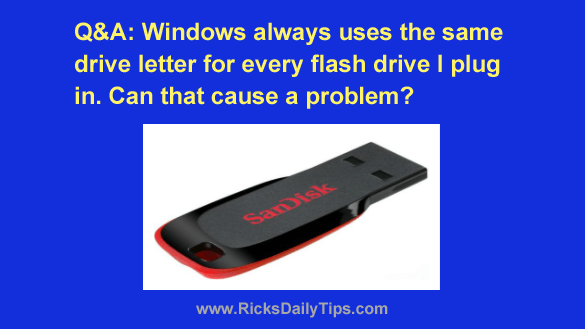 Question from Kendra: I have three USB flash drives that I use to store various files that I use from time to time.
Question from Kendra: I have three USB flash drives that I use to store various files that I use from time to time.
I’ve noticed that when I remove a flash drive and plug in a different one Windows uses the same drive letter (D:) for that drive that it was using for the previous drive.
Can that cause a problem? Like, could Windows get the files on the two drives confused somehow and corrupt one of the flash drives?
Rick’s answer: You’re wise to be worried about your USB flash drives developing problems over time, Kendra.
They’re indeed a bit unstable compared to hard drives and SSDs and problems with their file systems are very common.
But that being said, Windows’ use of the same drive letter for every flash drive you connect to your PC won’t cause any problems at all.
The drive letters that Window’s assigns to attached drives are for the user’s benefit, not its own.
Windows has a virtually fool-proof way to distinguish between flash drives even when they’re assigned the same drive letter multiple times.
Every drive has its own file system that’s independent from all the other drives, and Windows knows which drive is which and which files “belong” to which drive.
Once a flash drive (or an external hard drive for that matter) has been disconnected from the system, the drive letter it was using is released for use by the next drive that you connect to the system.
Bottom line: You can use all the USB flash drives you want without having to worry about Windows getting them “confused” with one another.
There is one thing you do need to be aware of however…
By default, previous versions of Windows and early versions of Windows 10 “cached” the things you have written to a flash drive and actually write the new data to the drive later to speed things up a bit.
That means new data isn’t always written to the flash drive immediately in those earlier Windows versions.
If you simply remove the drive without formally ejecting it that new data won’t be written to the drive, and that will often cause the drive’s file system will to become corrupted.
It’s easy to tell Windows to “eject” a flash drive. Just click the “Eject” icon in the Notifications area and Windows will write any cached data to the drive, close any open files, and then tell you it’s safe to remove the drive from the system.
You can easily find the “Eject” icon by hovering your mouse over the icons in the Notifications area until “Safely Remove Hardware and Eject Media” pops up.
Bonus tip: This post explains why you shouldn’t use a USB flash drive for long-term storage of important documents.
Never miss a tip! Click here to sign up for my free Daily Tech Tips Email Newsletter!